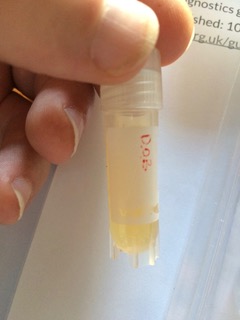PART 6: A Letter to the Chief Exec
You will remember from
reading Part 5 of our story, that Sheila had wanted to try for another two
cycles of Oxaliplatin, but in the event, the neuropathy from the sixth round of
chemotherapy didn’t disappear before the seventh round was due, so we all decided
that 6 cycles of Oxaliplatin was enough for Sheila after all.
With regards to the 5-FU,
even though we had reached a deal with Sheila’s oncologist that had given him a
way out from recognising our result that showed he was over-dosing her, something
just didn’t feel right about the accommodation we had reached with him. We
shouldn’t have to avoid the issue and do a deal with him; he should be
providing dose monitoring and adjustment as part of the chemo he was giving
Sheila. This just wasn’t right.
Thinking it over, I
realised that perhaps I was aiming my concerns at the wrong audience. Maybe
clinical oncologists don’t have the authority to change what they do, even if
they wanted to. I decided to take the issue away from the front line clinicians
and I wrote to the Hospital Trust’s Chief Executive, bringing the matter to his
attention and asking him why, based on plentiful good evidence, dose monitoring
and adjustment is not being carried out routinely, what he thought others might
say, if they knew and challenging him to make TDM routine. It was a long
letter, which you can read below:
The Chief Exec handed the
matter to his PALS Team Manager to handle on his behalf.
Meanwhile, Sheila never
got the chance to have her dose of 5-FU reduced because over the New Year, this
year, she had three episodes of angina-like pain and was taken off 5-FU as a
consequence. Angina-like pain is a known but uncommon side effect of 5-FU and
if severe enough, can lead to a full blown heart attack and death! On 2nd Jan
this year we both ended up in our local hospital’s Emergency Department, whilst
they checked Sheila over properly. Thankfully, nothing was found, but we didn’t
get home until the middle of the night and I didn’t get back to work the next day
after the holiday season!
At this point, I took the
opportunity to write to the PALS Manager at the Christie with some additional
information that I had learnt since writing my first letter and also expressing
my concern that Sheila’s angina-like episodes may have been brought about or
exacerbated by being over-dosed with 5-FU. The information that I had learnt
was that recently, the International Association of Therapeutic Drug Monitoring
and Clinical Toxicology has strongly recommended Therapeutic Dose Monitoring
for the management of 5-FU therapy in patients with colorectal or head-and-neck
cancer receiving common 5-FU regimens and I thought it was important that they
considered that in their response to my original letter. You can read that
letter below:
When we next saw Sheila’s oncologist, he already knew of her episodes of angina-like pain, as I would have expected and he offered to stop her chemotherapy altogether or swap her on to Raltitrexed, which I had identified in my letter to the PALS Manager above, even though it is not licensed in the UK in Sheila’s circumstances - I wonder if that was coincidental? Sheila chose two cycles of Raltitrexed to complete her full course of chemotherapy, as I knew she would; she’s a trooper!
Her oncologist also
ordered up an echocardiogram for her, to check there had been no damage done to
her heart and thankfully, there hadn’t been.
Follow this blog next
week, to find out what The Chief Exec had to say in answer to my letters.



Comments
Post a Comment